ACUFO-1920-09-00-BASSSTRAIT-1
The British ufology magazine Flying Saucer Review of January 1986 published the full text of an article by the ufologist Paul Norman as it appeared in the proceedings of the 1984 symposium of the American ufology group Mutual UFO Network; which Paul Norman also used to read during his lecture in the United States and Africa in 1984.
Paul Norman was a former Navy officer in the USA, then an engineer in charge of hydroelectric and thermoelectric power stations. He became interested in UFOs in 1953, explaining that he had seen one hovering over a power plant in Tennessee.
In 1963, he had moved to Melbourne, Australia, and became one of the leading UFO sightings investigators in that country, becoming the Vice President and head of investigations for the ufology group VUFORS, representative of MUFON in Victoria, and member of the J. Allen Hynek Center for UFO Studies (CUFOS).
In his text, Paul Norman asserted that there had been an official investigation in Australia about unusual aerial phenomena at least as early as 1920, when the S.S. Amelia J. ship disappeared at a time when unexplained lights were observed around the entrance to Bass Strait.
He stated that a search plane had been sent to investigate the lights and had disappeared.
Another version can be found in the 1989 book “Modern Mysteries of the World” by Janet and Colin Bord; in which we are told that in 1920, on the Bass Strait, state of Victoria, Australia, two planes searching for a missing schooner saw unusual lights in the sky. One of the planes had approached to identify the lights, but it disappeared into a cloud and never came out again. No trace of the schooner was ever found either.
Reading the press of the time, I noted that there was indeed an affair in the Bass Strait in September 1920: the disappearance of the schooner S.S. Amelia J.; the sending of ships and seaplanes in vain search, the disappearance of one of the seaplanes. Captain Stutt's DH.9A, sent in search of the SS Amelia J, had been lost, having last been seen entering heavy clouds on the northwest coast of Cape Barren Island.
The “UFO” or “mysterious lights” aspect of the case is, however, quite tenuous.
There was a light seen from the ground on Flinders Island. The Advocate newspaper, of Burnie, Tasmania, for September 24, 1920, reported receiving from the Flinder's Island radio station a report of “an unusual light coming from Settlement Point, also seen from different parts of the island”, which was like “a great star, changing colors, red, white and blue.” The radio station thought it might have been a distress parachute flare, and wondered whether it might be related to the missing schooner.
But the same day, The Herald, of Melbourne, published that the unusual light “reported to have been seen near Flinders Island is now believed to be the planet Venus.”
However, still on September 24, 1920, the Daily Advertiser, from Wagga Wagga in New South Wales, assured that planes sent to search for the SS Amelia J., located a height of 8,000 feet, had searched Bass Strait and the east coast of Tasmania, and “news had been received that unusual lights had been seen at Settlement Point, Flinders Island and the warship the nearest had been sent to this location.”
Which would confirm that Paul Norman was not wrong in talking about unusual lights seen by pilots.
There have also been reports from many St. Helen residents claiming to have seen a dozen white lights. One wondered whether these were distress flares from the pilot of the lost seaplane, but one could not tell if he had taken a dozen flares with him. It was thought that possible distress signals between Gould's Country and the coast were flares sent by opossum hunters, explaining that it was usual for hunters to have acetylene gas torches for this purpose, and that it was difficult to understand why they would have resorted to rockets, especially since the opossum hunting season was closed.
A last allusion to a “light” appeared in November 1920. The press mentioned that a “ball of fire” had been seen falling from the sky towards the sea, and an official investigator thought it might have been the lost seaplane, having caught fire due to additional gas tanks being added and possibly having had piping poorly secured against fire.
We therefore clearly see several “disappearances”, which have remained unsolved, and “lights”; but ufological sources have failed to point out the possible ordinary explanations published in the local contemporary Press.
| Date: | September 1920 |
|---|---|
| Time: | ? |
| Duration: | ? |
| First known report date: | September 24, 1920 |
| Reporting delay: |
| Country: | Australia |
|---|---|
| State/Department: | Victoria |
| City or place: | The Bass Strait |
| Number of alleged witnesses: | Several |
|---|---|
| Number of known witnesses: | ? |
| Number of named witnesses: | 0 |
| Reporting channel: | The local Press. |
|---|---|
| Visibility conditions: | ? |
| UFO observed: | Yes. |
| UFO arrival observed: | ? |
| UFO departure observed: | ? |
| UFO action: | ? |
| Witnesses action: | ? |
| Photographs: | No. |
| Sketch(s) by witness(es): | No. |
| Sketch(es) approved by witness(es): | No. |
| Witness(es) feelings: | ? |
| Witnesses interpretation: | Distress flares. |
| Sensors: |
[X] Visual: Several.
[ ] Airborne radar: N/A. [ ] Directional ground radar: N/A. [ ] Height finder ground radar: N/A. [ ] Photo: [ ] Film/video: [ ] EM Effects: [ ] Failures: [ ] Damages: |
|---|---|
| Hynek: | NL or DD |
| Armed / unarmed: | Unarmed. |
| Reliability 1-3: | 3 |
| Strangeness 1-3: | 1 |
| ACUFO: | No strangeness. |
[Ref. pnm1:] PAUL NORMAN:
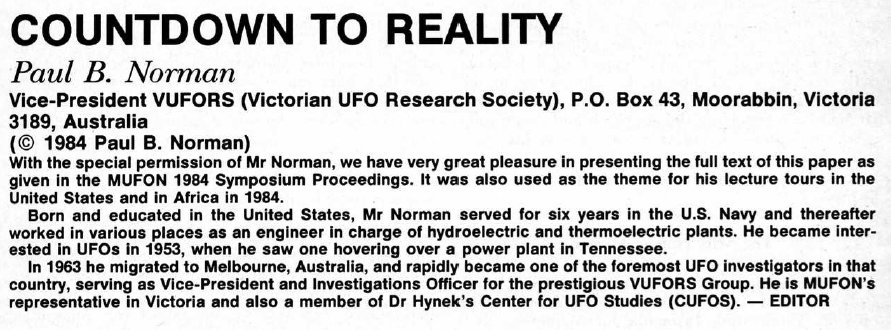
|
Paul B. Norman
Vice-President VUFORS {Victorian UFO Research Society), P.O. Box 43, Moorabbin, Victoria 3189, Australia
(© 1984 Paul B. Norman)
With the special permission of Mr. Norman, we have very great pleasure in presenting the full text of this paper as given In the MUFON 1984 Symposium Proceedings. It was also used as the theme for his lecture tours in the United States and In Africa in 1984.
Born and educated in the United States, Mr. Norman served for six years in the U.S. Navy and thereafter worked in various places as an engineer In charge of hydroelectric and thermoelectric plants. He became interested In UFOs In 1953, when he saw one hovering over a power plant In Tennessee.
In 1963 he migrated to Melbourne, Australia, and rapidly became one of the foremost UFO Investigators In that country, serving as Vice-President and Investigations Officer for the prestigious VUFORS Group. He Is MUFON's representative in Victoria and also a member of Dr. Hynek's Center for UFO Studies (CUFOS). - EDITOR
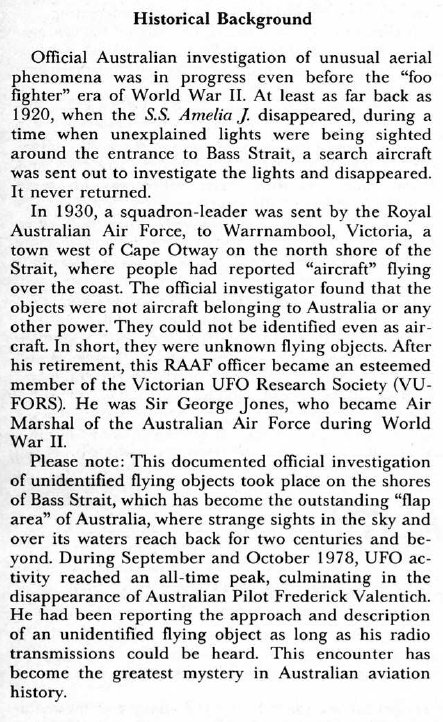
|
Official Australian investigation of unusual aerial phenomena was in progress even before the “foo fighter” era of World War II. At least as far back as 1920, when the S.S. Amelia J disappeared, during a time when unexplained lights were being sighted around the entrance to Bass Strait, a search aircraft was sent out to investigate the lights and disappeared. It never returned.
In 1930, a squadron-leader was sent by the Royal Australian Air Force, to Warrnambool, Victoria, a town west of Cape Otway on the north shore of the Strait, where people had reported “aircraft” flying over the coast. The official investigator found that the objects were not aircraft belonging to Australia or any other power. They could not be identified even as aircraft. In short, they were unknown flying objects. After his retirement, this RAAF officer became an esteemed member of the Victorian UFO Research Society (VUFORS). He was Sir George Jones, who became Air Marshal of the Australian Air Force during World War II.
Please note: This documented official investigation of unidentified flying objects took place on the shores of Bass Strait, which has become the outstanding “flap area” of Australia, where strange sights in the sky and over its waters reach back for two centuries and beyond. During September and October 1978, UFO activity reached an all-time peak, culminating in the disappearance of Australian Pilot Frederick Valentich. He had been reporting the approach and description of an unidentified flying object as long as his radio transmissions could be heard. This encounter has become the greatest mystery in Australian aviation history.
[Ref. bcr1:] BILL CHALKER:
The official files do not confirm military activity before 1950, however research has confirmed involvement by the military, albeit in some cases, cursory in nature, back as far as 1920. The Navy submarine depot ship, the Platypus, was involved in the search for a missing schooner, the Amelia J., in Bass Strait. Mystery lights, thought at the time to be “evidently rockets”, were observed. Two aircraft left the flying training school and aircraft depot at Point Cook to join in the investigation. One was piloted by a Major Anderson and the other by Captain W.J. Stutt - an instructor for the NSW Government Aviation school at Richmond (a forerunner to the Richmond RAAF base, established soon after the birth of the RAAF in 1921). Stutt and his mechanic, Sergeant Dalzell, were last seen by Major Anderson flying into a large cloud. Their plane and the schooner were never found. Fifty eight years later the Bass Strait became the centre of another extraordinary plane/pilot disappearance, namely the Valentich affair of 1978.
[Ref. gvo1:] GODELIEVE VAN OVERMEIRE:
1920,
AUSTRALIA, Bass strait (Victoria)
Two planes were circulating over the strait in search of a missing schooner. They saw unusual lights in the sky. One of the planes was getting closer to identify them. The plane disappeared into a cloud and never came out. No trace of the schooner either. (Janet and Colin BORD: “Modern Mysteries of the World”, Guild Publishing London 1989, p. 310) (vog note: no plane crash or loss on this date and in this place in the database http://www.planecrashinfo.com/database.htm Copyright 1997-2004 Richard Kebabjian)
[Ref. tgd1:] TIMOTHY GOOD:
...more serious attention was paid in 1920, when unexplained lights were seen in the sky around the entrance to the Bass Strait, Australia, around the time a ship, SS. Amelia J., had disappeared. The search aircraft sent to investigate also disappeared without trace.
The source is detailed as Paul Norman, “Countdown to Reality”, in Flying Saucer Review, Vol 31, No 2, 1986, pp 13-22.
[Ref. kbd3:] KEITH BASTERFIELD:
The Navy submarine depot ship, the Platypus, was involved in the search for a missing schooner, the Amelia J., in Bass Strait. Mystery lights, thought at the time to be “evidently rockets,” were observed. Two aircraft left the flying training school and aircraft depot at Point Cook to join in the investigation. One was piloted by a Major Anderson and the other by Captain W. J. Stutt - an instructor for the NSW Government Aviation school at Richmond... Stutt and his mechanic, Sergeant Dalzell, were last seen by Major Anderson flying into a large cloud. Their plane and the schooner were never found.
Source: Chalker, C. 1996. UFOs Sub Rosa Down Under: The Australian Military & Government role in the UFO controversy.
http://www.project1947.com/forum/bcoz1.htm#strange
The contemporary Press indicated that both Stutt and Anderson flew on DH.9A planes in the search for the SS Amelia J.
The Airco DH.9A was initially a British single-engine light bomber first used shortly before the end of the First World War. Seaplane versions (photo below) were used in the 1920's in Australia.
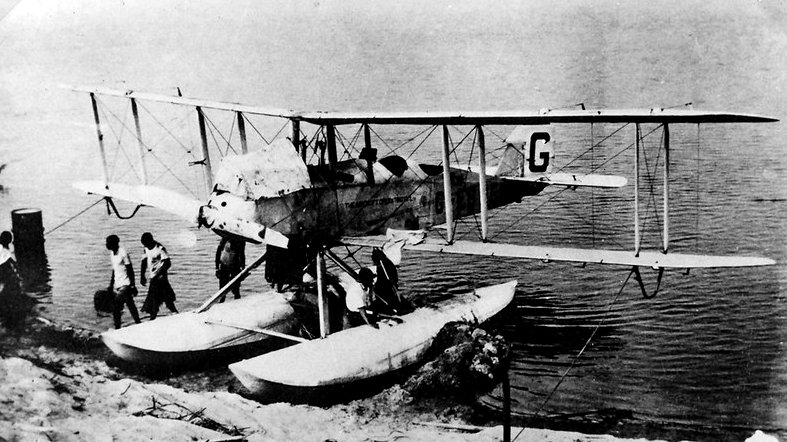
|
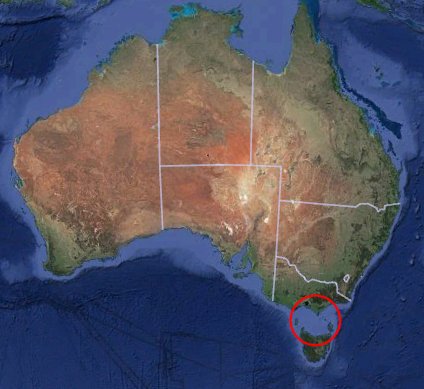
|
According to wrecksite.eu/wreck.aspx?54130, the three-masted schooner SS Amelia J, 404/353 tons, built in Hobart in 1919, commanded by Captain George Atwell, sailed from Newcastle for Hobart on 21 August 1920 with coal and a total crew of twelve, but failed to arrive.
It was last seen off Jervis Bay, New South Wales, by the crew of SS Melbourne on September 5, 1920. The Amelia J owners arranged for SS Musgrave to conduct a search of the Furneaux Group, beginning what was probably the largest search for a missing vessel yet conducted in Australia, and the first to make use of aircraft. The Government initially refused to send a warship in search of the Amelia J., but the public outcry was so great that HMAS Platypus was sent to investigate the Furneaux Group, considered to be the most likely spot the vessel may have disappeared. On September 23, 1920, two De Havilland 9A biplanes took off to fly over the Furneaux Group. One of these, flown by Major Stutt, was last seen flying into heavy cloud on the north-western coast of Cape Barren Island before it too disappeared, and the search for the missing schooner had to be extended to cover it as well.
According to the HMAS Swordsman history of the Royal Australian Navy at www.navy.gov.au, the SS Amelia J, a schooner, disappeared on September 10, 1920. HMAS Swordsman was commissioned to search for the ship, and while searching the Bass Strait, a second ship - the barquentine SS Southern Cross - disappeared.
According to the 1980 book “The Devil's Meridian” by Kevin Killey and Gary Lester, pp. 26 31, - it argues that Bass Strait has mysterious disappearances of ships and planes alike the infamous “Bermuda Triangle” - a military Airco DH.9A engaged in the search for the SS Amelia disappeared. [7][8] Wreckage of the SS Southern Cross was found on King Island; the SS Amelia J was never discovered, and neither was the Airco DH.9A.
A fiction story exists, titled “The Sea and the Sky”, by Debbie Robson, at bombaylitmag.com/the-sea-and-sky. It seems to be the only source mentioning “lights” and clearly in connection with the search for SS Amelia J:
“Two planes had set out yesterday at midday from Point Cook, Victoria to search for the Amelia J, heading for the Kent Group, Flinders Island and then on down the east coast of Tasmania towards Hobart. I was fascinated to read that mysterious lights were seen at Settlement Point on Flinders Island, possibly distress signals, "like a star changing colour", red, white and blue . Other lights were seen in a heavily wooded area around St Helens in Tasmania. A resident of Vansittart Island saw two planes flying overhead and going south east towards Cape Barren Island. I made more notes in my book.”
In the article “Bass Strait Mystery”, in the Coast Guard Magazine of June 2021, at magazine.slcoastguard.org/bass-strait-mystery, we read:
The SS Amelia J, a schooner, disappeared on 10 September. HMAS Swordsman was commissioned to search for the ship, and while searching the Bass Strait, a second ship - the barquentine SS Southern Cross - disappeared. A military Airco DH.9A engaged in the search would also then disappear. Wreckage of the SS Southern Cross was found on King Island; the SS Amelia J was never discovered, and neither was the Airco DH.9.
The De Havilland Express Miss Hobart, went missing soon after entering service in 1934, only a small amount of wreckage being found on the Victorian coast. In 1935 Loina, a Holyman airliner, crashed into the sea near Flinders Island with three crew and two passengers lost. No bodies were found. The cause of both accidents was probably a combination of human error with the known poor design of the aircraft.
A search of the contemporary Press gives the following information.
There were about 3000 newspaper articles about the events in 1920 only; I provide those articles that mention searches by planes, disappearances of planes, I omit the many articles merely stating that the search for Amelia J was hopeless or that no news of the shipwreck surfaced.
The Mercury, Hobart, Tasmania, for September 23, 1920, page 4:
The State Government and the Hobart Marine Board between them are doing all that is possible to obtain news of the missing schooner, the Amelia J.
The State-owned steamer Melbourne has been instructed to set off at once on a search, and if possible a seaplane will be obtained to accompany her and aid. But the Federal Government, whose special business this should be, is quite indifferent. The Premier has sent two urgent telegrams to the Prime Minister, who, apparently, has not even taken the trouble to reply to them. The ships of the Australian navy are lying idle in Sydney Harbour, and eleven men are somewhere out on the ocean in peril either of drowning or of the more horrible fate of starvation. This cold-blooded indifference is beyond the reach of comment; it is a crime of such magnitude that we can do no more than record it. If those eleven men die, who might have been saved, the responsibility will press heavily on the shoulders of those whose indifference will have made their loss certain.
The Evening News, Sydney, New South Wales, for September 23, 1920, page 6:
HOBART, Thursday. There is no news yet of the missing schooner Amelia J. The newspapers here speak in the strongest condemnatory language against the Federal Government for not utilising the services of one of the vessels at Sydney to go in search.
Captain Cumming, an airman, is awaiting reply from the Naval Department to his request for the use of a seaplane for the search.
The Sun, Sydney, New South Wales, for September 24, 1920, page 5:
MELBOURNE, Thursday. Mr. Hughes (Prime Minister) announced to-day that the Federal Government had despatched H.M.A.S. Platypus, the mother ship of the Australian destroyer squadron, to search for the missing schooner Amelia J.
Two D.H. 9A aeroplanes were despatched by the Defence Department from Point Cook this morning to join the search. The aviators were given instructions to make a thorough inspection of the coast as far as Port Albert, and then branch across to examine the neighborhood of the numerous islands. They will also make a search along the east coast of Tasmania, and will probably land at Brighton, near Hobart.
Information was received by the Navy Department this afternoon from King Island that a considerable amount of wreckage had been discovered near land at Glassy River entrance. It consisted of a sailing vessel 50 feet long, painted white, a broken oar branded D.U.C., a case of benzine, pieces of furniture, and piece of a case branded “Hobart.” The vessel had evidently been burnt.
Although the Amelia J. was owned in Hobart, it is regarded as highly improbable that the wreckage is that of the missing vessel. King Island is well out of the vessel's course from Sydney to Hobart, and as far as the agents know, nothing has been found that could connect the burnt ship with the Amelia J.
The Evening News, Sydney, New South Wales, September 25, 1920, page 5:
The steamer Melbourne, which is going to search for the missing schooner Amelia J., has been delayed in Newcastle owing to a broken steam pipe. She will not be able to reach Sydney till tomorrow morning.
On arrival, the Melbourne will anchor in Double Bay, where one of the Aerial Company's flying boats will be shipped. Mr. C. V. Ryrie, who is to pilot the machine, and an observer and a mechanic, will board the Melbourne, together with Captain Heather, Marine Superintendent for H. Jones and Company, Hobart, who is to represent the owners of the Amelia J.
The steamer will then put to sea and search 300 miles from the coast before heading south, and the flying boat is to ascend at intervals, and fly in circles of two miles radius.
Advisers from Tasmania state that Major Anderson, of the Flying Corps, who has been searching for the schooner, set out yesterday to look for Captain Stutt, another airman.
The latter left Point Cook aerodrome with Major Anderson on Thursday last, and has not yet been reported.
The Sun, Sydney, New South Wales, September 27, 1920, page 1:
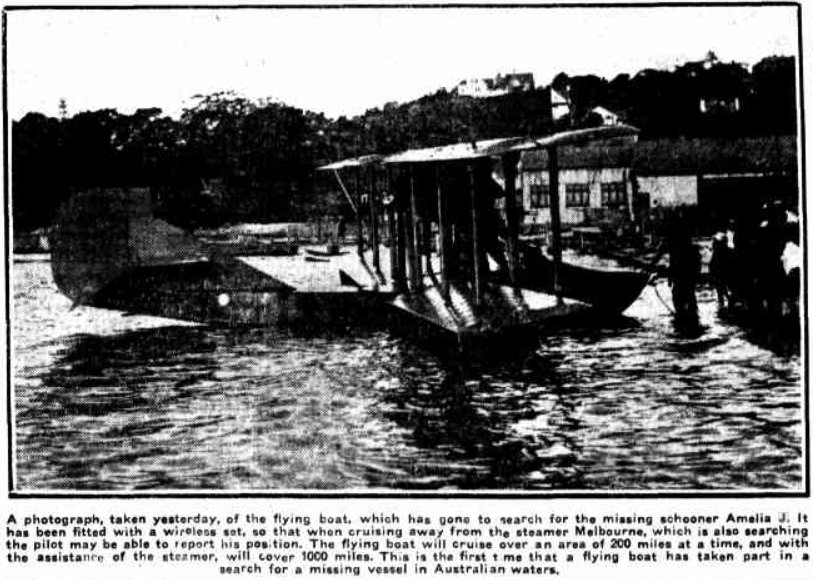
|
A photograph, taken yesterday, of the flying boat, which has gone to search for the missing schooner Amelia J. It has been fitted with a wireless set, so that when cruising away from the steamer Melbourne, which is also searching the pilot may be able to report his position. The flying boat will cruise over an area of 200 miles at a time, and with the assistance of the steamer, will cover 1000 miles. This is the first time that a flying boat has taken part in a search for a missing vessel in Australian waters.
The Armidale Express and New England General Advertiser, New South Wales, Australia, for September 28, 1920, page 4:
Sydney, Monday. - There is no farther news of Captain. Stutt, who left in an aeroplane on Thursday in search of the Amelia J. The steamer Melbourne, with a seaplane on board, left to search for the Amelia J.
The Newcastle Sun, New South Wales, for September 29, 1920, page 1 , published this photo of “The missing airman, Captain Stutt, in his machine”:
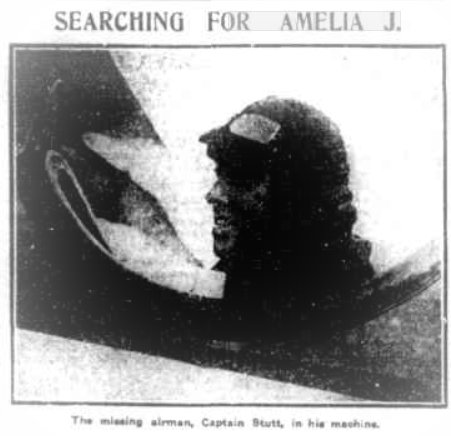
|
In the Press, the reports of “mysterious lights” did appear.
For example, the Advocate, Burnie, Tasmania, for September 24, 1920, reported on page 3:
AEROPLANES SEARCHING
HOBART, Thursday. -- The Premier has received the following telegram from the Prime Minister regarding the missing schooner Amelia J.:
“Aeroplane already searching coast.
Another leaving to-day.”
The following has been received from the Flinder's Island radio station:
“Flinder's Island reports having seen unusual light showing from Settlement Point, also seen from different parts of the island and reported to me. Like a large star, changing colors, red, white and blue. While answering telephone call from Warden, the light went out. Apparently parachute light. It may be of interest in connection with the missing schooner Amelia J.”
The Premier has sent an urgent wire to the constable at the island asking if he has any information on the matter.
The acting Naval Commandant has received a wire from King Island that wreckage consisting of the side of a vessel about 30 feet long has been found on the coast line. Further details are being sent.
(The same information appeared in other newspapers.)
But the same day, September 24, 1920, in The Herald, Melbourne, Victoria, on page 7, we learn:
HOBART. Friday. No news has been received of the missing barquentine, Amelia J.
Investigation has proved that there was nothing in the report that a dismasted vessel had been sighted.
The unusual light reported as having been seen near Flinders Island is now considered to have been the planet Venus.
This is however diminished by another report that “lights” (plural) were also spotted near Flinders Island from aeroplanes, as report in the Daily Advertiser, Wagga Wagga, New South Wales, also on September 24, 1920, page 3:
The Minister for the Navy, Mr Laird Smith, states that since the announcement of the Amelia J. was missing on the voyage from Newcastle to Hobart he had been approached by every Tasmanian member urging him to have a search made. He at once wirelessed all ships in the area to keep a lookout for the Amelia J. No torpedo boat or destroyer was available, but acting on the suggestion of a constituent he had at once sent out aeroplanes which, at a height of 8000 feet, had searched the Bass Straits and the east coast of Tasmania, and news had been received that unusual lights had been seen at Settlement Point, Flinders Island and the nearest war vessel had been despatched to that place.
The Daily Telegraph, Launceston, Tasmania, for October 4, 1920, page 5:
The vigorous search of the eastern extremities of Tasmania, including the outlying islands, was continued on Saturday, when both airmen carried out a prolonged investigation of these regions in an attempt to discover signs of Captain Stutt and his mechanic, Sergeant Dalzell, who have now been missing about ten days. It will be remembered that, whilst flying from Melbourne to Tasmania in company with Major Anderson, to look for wreckage of the Amelia J., Captain Stutt disappeared into a fog bank, never to reappear. After some lapse of time search was commenced by every conceivable means, and the daily reports received have up to the present not been enlightening as to the fate of the unfortunate aviator. Hope has by no means been abandoned, and as Major Anderson recently remarked, Captain Stutt may turn up in some out of the way place where least expected. Both Captain Lukis and Major Anderson took the air early on Saturday morning, the former proceeding towards Flinders Island, thence to Cape Barren and Clarke Islands, without definite result. There was no sight of the aeroplane or wreckage from the Amelia J.
Major Anderson, with sergeant Chester, left from Freeland's aerodrome at 10:30 a.m. on Saturday morning, and stayed three and a half hours in the air, flying over the thickly wooded country about St. Helen's, from whence the supposed lights were first observed. Observation from the plane was a difficult matter, on account of the trees, and consequently the ground was mostly obscured from direct vision. Returning to Launceston at 1:30 p.m., Mr Reynolds, manager of Heatborn's garage, motored Major Anderson back to St. Helen's, where strenuous enquiries were made to residents and members of the search parties respecting the kind of light observed and its locality. It was ultimately the aviator's conviction that the style corresponded with that of a Verey light, six of- which should have formed portion of Captain Stutt's outfit. The exact number he carried is not, definitely known, however, and Major Anderson has wired to Melbourne requesting this information, so that on the point in question he can eventually reach a definite conclusion. In number, residents affirm that about a dozen white lights have been seen, and if therefore Captain Stutt did not carry this number, the probability of his being in the bush there becomes a matter of doubt.
It has been suggested that the distress signals between Gould's Country and the coastere rockets that have been sent up by men who are out opossum hunting. It is usual for hunters to have acetylene gas flares for their purpose, and it is hard to understand why, in this instance, they should resort to rockets, especially as this as this the close season for opossums.
Major Anderson said last night that the machine used by Captain Stutt was a heavy one, and even if flying low, the least it could hit the trees it would he about 50 miles an hour. He doubted if such a force could be withstood by the timber, which would in such case act as a cushion and so break the fall of the occupants. Otherwise the crash must necessarily be with tremendous impact. Supposing the best of bad fortune had attended a landing the possibility of broken limbs and the denseness of the bush, added to which is the fact that the damp state of the scrub would make a fire impossible, all tend to add to the difficulties of discovering the airmen, if indeed they be confined somewhere about St. Helen's. The locality was at first extensive, but by continuous search this area has now been narrowed down to fairly close limits, and the deciding investigations would reveal the presence or otherwise of the hopeless men.
Major Anderson returned in Mr Reynold's car last evening, and will this morning again fly over the St. Helen's area. The aviator realises the disadvantages of flying over the densely wooded country, but considers that the deafening noise of his engines could not fail to be heard by those below who might, if opportunity offered, attract attention by some means or other. After a tour of the land he will proceed towards Flinders Island, where Captain Lukis is conducting a search, aided by the destroyer Swordsman and at the same time get into communication with the Dolphin.
Up to a late hour last night the superintendent of police (Mr S. Weston) had received no news from the search parties. Sergeant Beresford, left St. Helen's two or three days ago in the motor ship Toroa, alter having participated in the search, but as the superintendent has not received his report, he was feeling somewhat apprehensive for the safety of the vessel.
According to the telegraphic shipping reports, however, the Toroa left Eddystone, at 6 p.m on Saturday, and therefore should be now in port.
In the Albury Banner and Wodonga Express, New South Wales, for November 12, 1920, on page 33, an article about the disappearance of Stutt's plane tells of the investigation by Captain Wicket of the Air Corps into the possibility that extra fuel tanks of the plane could have set fire to the plane:
The machine had two tanks, which had been put on at the request of Captain Wickett for the testing of different types of petrol. He did not know why the tanks were not removed. Maurice S. Smith, a member of Tarrant Motors Ltd., described the part he took in the search for the missing airmen. It it were really true, as had been reported from Tasmania, he said, that a ball of fire was seen to fall from skywards into the sea, witness would be inclined to think that the machine containing the missing airmen caught fire, and that the two extra petrol tanks on the aeroplane might have something to do with it. 'I take it,' he added, 'that there were two, pipes fitted to the tanks, and that they must have been joined at some point between the tanks and the carburettor. The tanks were foreign to the machine. If the joining pipes, subjected to strain, had broken, the petrol would rush out and would be very likely to ignite.'
The Examiner, Launceston, Tasmania, for November 4, 1920, also referred to the “ball of fire” report, on page 6:
Referring to a statement which appeared in the Tasmanian press to the effect that what resembled a ball of fire had been seen to drop from the sky into the sea, witness held to a theory that the aeroplane caught fire.
No strangeness.
* = Source is available to me.
? = Source I am told about but could not get so far. Help needed.
| Main author: | Patrick Gross |
|---|---|
| Contributors: | None |
| Reviewers: | None |
| Editor: | Patrick Gross |
| Version: | Create/changed by: | Date: | Description: |
|---|---|---|---|
| 0.1 | Patrick Gross | April 9, 2024 | Creation, [pnm1], [gvo1], [tgd1]. |
| 1.0 | Patrick Gross | April 9, 2024 | First published. |
| 1.1 | Patrick Gross | April 25, 2024 | Additions [bcr1], [kbd3]. |